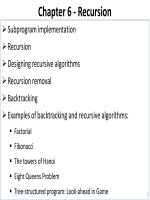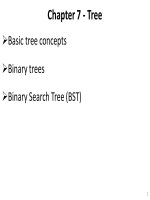Data Structures and Algorithms - Chapter 9: Hashing pot
Bạn đang xem bản rút gọn của tài liệu. Xem và tải ngay bản đầy đủ của tài liệu tại đây (124.32 KB, 54 trang )
1
01 December 2008
Cao Hoang Tru
CSE Faculty - HCMUT
Chapter 9: Hashing
• Basic concepts
• Hash functions
• Collision resolution
• Open addressing
• Linked list resolution
• Bucket hashing
2
01 December 2008
Cao Hoang Tru
CSE Faculty - HCMUT
Basic Concepts
• Sequential search: O(n) Requiring several
key comparisons
• Binary search: O(log
2
n) before the target is found
3
01 December 2008
Cao Hoang Tru
CSE Faculty - HCMUT
Basic Concepts
1,000,000500,000201,000,000
100,00050,00017100,000
10,0005,0001410,000
1,000500101,000
2561288256
5025650
168416
Sequential
(Worst Case)
Sequential
(Average)
BinarySize
• Search complexity:
4
01 December 2008
Cao Hoang Tru
CSE Faculty - HCMUT
Basic Concepts
• Is there a search algorithm whose complexity is
O(1)?
5
01 December 2008
Cao Hoang Tru
CSE Faculty - HCMUT
Basic Concepts
• Is there a search algorithm whose complexity is
O(1)?
YES.
6
01 December 2008
Cao Hoang Tru
CSE Faculty - HCMUT
Basic Concepts
memory addresses
keys
hashing
Each key has only one address
7
01 December 2008
Cao Hoang Tru
CSE Faculty - HCMUT
Basic Concepts
John Adams100
Ray Black007
Vu Nguyen005
Sarah Trapp002
Harry Lee001
Key
Address
Vu Nguyen 102002
John Adams 107095
Sarah Trapp 111060
Hash
Function
005
100
002
8
01 December 2008
Cao Hoang Tru
CSE Faculty - HCMUT
Basic Concepts
• Home address: address produced by a hash
function.
• Prime area: memory that contains all the home
addresses.
9
01 December 2008
Cao Hoang Tru
CSE Faculty - HCMUT
Basic Concepts
• Synonyms: a set of keys that hash to the same
location.
• Collision: the location of the data to be inserted is
already occupied by the synonym data.
10
01 December 2008
Cao Hoang Tru
CSE Faculty - HCMUT
Basic Concepts
• Ideal hashing:
– No location collision
– Compact address space
11
01 December 2008
Cao Hoang Tru
CSE Faculty - HCMUT
Basic Concepts
[17][9][5][1]
A
Insert A, B, C
hash(A) = 9
hash(B) = 9
hash(C) = 17
12
01 December 2008
Cao Hoang Tru
CSE Faculty - HCMUT
Basic Concepts
[17][9][5][1]
BA
B and A
collide at 9
Collision Resolution
Insert A, B, C
hash(A) = 9
hash(B) = 9
hash(C) = 17
13
01 December 2008
Cao Hoang Tru
CSE Faculty - HCMUT
Basic Concepts
[17][9][5][1]
BAC
B and A
collide at 9
Collision Resolution
Insert A, B, C
hash(A) = 9
hash(B) = 9
hash(C) = 17
B and A
collide at 9
C and B
collide at 17
14
01 December 2008
Cao Hoang Tru
CSE Faculty - HCMUT
Basic Concepts
[17][9][5][1]
BAC
Probing
Searh for B
hash(A) = 9
hash(B) = 9
hash(C) = 17
15
01 December 2008
Cao Hoang Tru
CSE Faculty - HCMUT
Hash Functions
• Direct hashing
• Modulo division
• Digit extraction
• Mid-square
• Folding
• Rotation
• Pseudo-random
16
01 December 2008
Cao Hoang Tru
CSE Faculty - HCMUT
Direct Hashing
• The address is the key itself:
hash(Key) = Key
17
01 December 2008
Cao Hoang Tru
CSE Faculty - HCMUT
Direct Hashing
• Advantage: there is no collision.
• Disadvantage: the address space (storage size) is
as large as the key space
18
01 December 2008
Cao Hoang Tru
CSE Faculty - HCMUT
Modulo Division
Address = Key MOD listSize + 1
• Fewer collisions if listSize is a prime number
• Example:
Numbering system to handle 1,000,000 employees
Data space to store up to 300 employees
hash(121267) = 121267 MOD 307 + 1 = 2 + 1 = 3
19
01 December 2008
Cao Hoang Tru
CSE Faculty - HCMUT
Digit Extraction
Address = selected digits from Key
• Example:
379452 → 394
121267 → 112
378845 → 388
160252 → 102
045128 → 051
20
01 December 2008
Cao Hoang Tru
CSE Faculty - HCMUT
Mid-square
Address = middle digits of Key
2
• Example:
9452 * 9452 = 89340304 → 3403
21
01 December 2008
Cao Hoang Tru
CSE Faculty - HCMUT
Mid-square
• Disadvantage: the size of the Key
2
is too large
• Variations: use only a portion of the key
379452: 379 * 379 = 143641 → 364
121267: 121 * 121 = 014641 → 464
045128: 045 * 045 = 002025 → 202
22
01 December 2008
Cao Hoang Tru
CSE Faculty - HCMUT
Folding
• The key is divided into parts whose size matches
the address size
Key = 123|456|789
fold shift
123 + 456 + 789 = 1368
⇒
⇒⇒
⇒ 368
23
01 December 2008
Cao Hoang Tru
CSE Faculty - HCMUT
Folding
• The key is divided into parts whose size matches
the address size
Key = 123|456|789
fold shift fold boundary
123 + 456 + 789 = 1368 321 + 456 + 987 = 1764
⇒
⇒⇒
⇒
368
⇒
⇒⇒
⇒
764
24
01 December 2008
Cao Hoang Tru
CSE Faculty - HCMUT
Rotation
• Hashing keys that are identical except for the last
character may create synonyms.
• The key is rotated before hashing.
original key rotated key
600101 160010
600102 260010
600103 360010
600104 460010
600105 560010
25
01 December 2008
Cao Hoang Tru
CSE Faculty - HCMUT
Rotation
• Used in combination with fold shift
original key rotated key
600101 → 62 160010 → 26
600102 → 63 260010 → 36
600103 → 64 360010 → 46
600104 → 65 460010 → 56
600105 → 66 560010 → 66
Spreading the data more evenly across the address space









